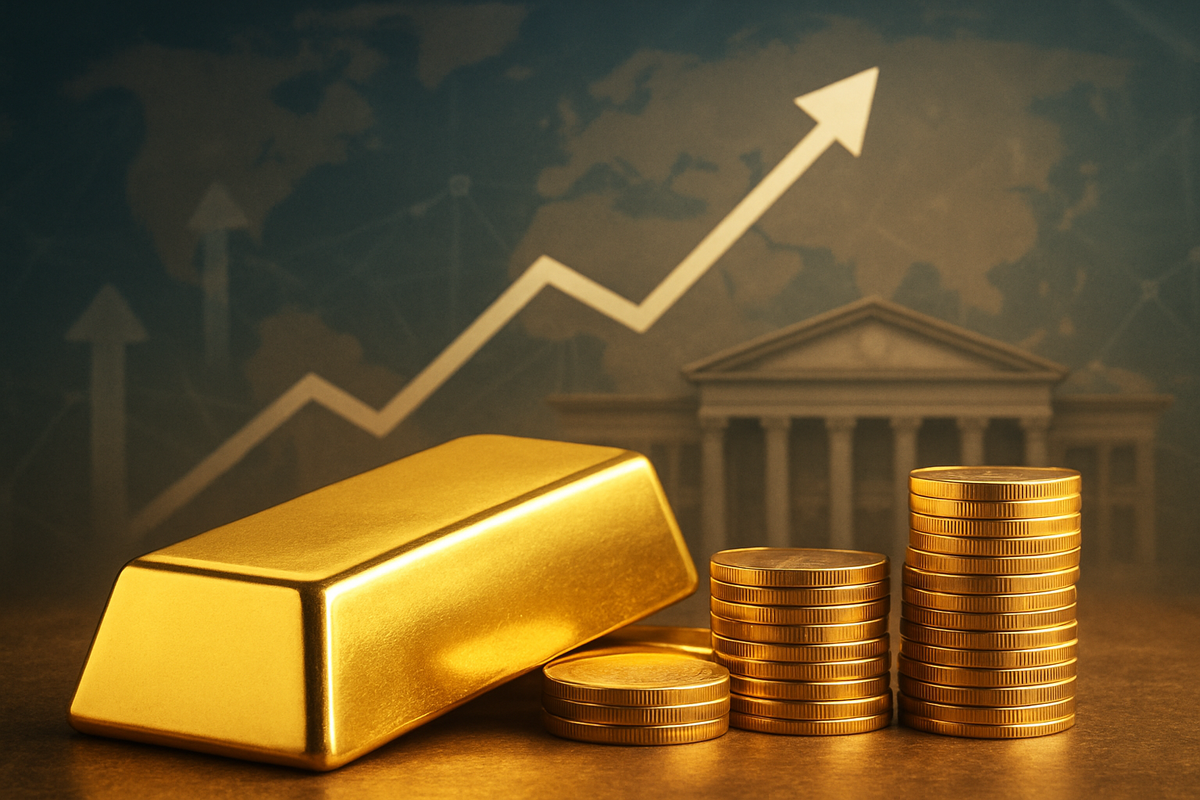
As of November 24, 2025, the global financial markets are witnessing a significant surge in gold prices, with the precious metal currently trading around $4,090.09 per troy ounce. This remarkable rally, representing a substantial 56.68% increase year-to-date, is primarily fueled by mounting market expectations for a Federal Reserve interest rate cut in December. Recent mixed signals from US economic data, pointing towards a cooling economy, have further solidified this sentiment, making non-yielding assets like gold increasingly attractive to investors seeking safe havens amidst evolving monetary policy landscapes.
The current upward trajectory of gold is a testament to its enduring appeal in times of economic uncertainty and shifting central bank policies. With bullion having touched an all-time high of $4,381.58 in October 2025, the $4,000 per ounce level has become a crucial psychological benchmark. This robust performance is underpinned by a confluence of factors, including persistent geopolitical tensions, robust central bank accumulation, and a sustained investor flight to quality assets, all of which are amplified by the anticipated dovish pivot from the Federal Reserve.
The Federal Reserve's Dovish Tilt and Influential Economic Data
The dramatic shift in market sentiment towards an imminent Federal Reserve interest rate cut has been the primary catalyst for gold's recent ascent. The probability of a 25-basis-point (bps) rate reduction in December 2025 has soared to between 69% and 77.9%, a significant jump from approximately 40% just a week prior. This recalibration of expectations followed a pivotal statement from New York Fed President John Williams on November 21st, who expressed support for a near-term rate cut, characterizing the current monetary policy as "modestly restrictive" with scope for adjustment. This dovish commentary effectively overshadowed earlier, more hawkish remarks from Federal Reserve Chair Jerome Powell, made earlier in November.
Several recent US economic data points have played a crucial role in shaping these interest rate expectations and, consequently, gold's appeal. A six-week government shutdown has unfortunately led to the delay or cancellation of critical economic reports, including the October Consumer Price Index (CPI) and the advance estimate for Q3 GDP. This data vacuum has injected an additional layer of uncertainty into the market, pushing investors towards traditional safe-haven assets.
Prior to the shutdown, the September jobs report presented a mixed but ultimately cooling picture of the labor market. While nonfarm payrolls increased by 119,000, exceeding some forecasts, the unemployment rate rose to 4.4%—its highest since 2021—and wage growth was softer than anticipated at 0.2% month-over-month. Furthermore, the September CPI report showed headline and core inflation rising 0.3% month-over-month and 3.0% year-over-year, which was softer than expected, reinforcing the narrative of moderating inflationary pressures. Earlier data for May had already indicated a Personal Consumption Expenditure (PCE) Price Index decline to 2.6%, further stoking rate cut hopes. These indicators, combined with a dip in the University of Michigan's consumer sentiment index for November, paint a picture of an economy that is gradually losing momentum, thereby increasing the likelihood of the Fed easing its monetary policy from the current federal funds rate of 3.75% to 4%.
The interrelation of these factors is clear: lower interest rates reduce the opportunity cost of holding non-yielding gold, making it more attractive relative to interest-bearing assets. Moreover, expectations of rate cuts often lead to a weakening US dollar, which in turn makes gold cheaper for international buyers and boosts demand. The prevailing economic uncertainty, compounded by geopolitical risks and sustained central bank gold purchases (particularly from nations like China and India), further solidifies gold's role as both a safe haven and an inflation hedge, collectively driving its price to new highs.
Companies Poised to Win or Lose in a Dovish Environment
With the prospect of Federal Reserve interest rate cuts looming large and gold prices soaring, various public companies across different sectors are likely to experience significant impacts. The immediate beneficiaries are typically gold mining companies, which see their revenue and profit margins expand as the price of their primary commodity increases. Companies such as Barrick Gold Corporation (NYSE: GOLD), Newmont Corporation (NYSE: NEM), and Agnico Eagle Mines Limited (NYSE: AEM) are directly exposed to gold price movements. Higher gold prices translate to increased cash flows, potentially leading to higher dividends, share buybacks, or investments in exploration and expansion projects. Investors often flock to these equities as a leveraged play on rising gold prices, anticipating substantial gains.
Conversely, a dovish Fed and a potentially weaker dollar, while beneficial for gold, could present challenges for other sectors. Financial institutions, particularly those heavily reliant on net interest margins (NIM), might face headwinds. Banks like JPMorgan Chase & Co. (NYSE: JPM) and Bank of America Corporation (NYSE: BAC) typically thrive in higher interest rate environments where the spread between what they pay on deposits and earn on loans is wider. A series of rate cuts could compress these margins, potentially impacting their profitability. However, some banks might also benefit from increased lending activity stimulated by lower rates, offsetting some of the margin pressure.
Beyond direct commodity and financial plays, companies with significant debt loads could see a reduction in their interest expenses, improving their bottom line. Sectors like utilities (e.g., NextEra Energy, Inc. (NYSE: NEE)) and real estate investment trusts (REITs) (e.g., Prologis, Inc. (NYSE: PLG)), which often carry substantial debt to finance their operations and acquisitions, could experience a positive impact from lower borrowing costs. Conversely, companies that benefit from a strong dollar, such as certain multinational corporations with significant international sales, might see their foreign earnings converted back into fewer dollars, potentially dampening their reported profits. The overall sentiment of a cooling economy, while prompting rate cuts, could also signal slower consumer spending, impacting consumer discretionary companies like Amazon.com, Inc. (NASDAQ: AMZN) or Nike, Inc. (NYSE: NKE), although lower rates might also stimulate borrowing for larger purchases.
Wider Significance and Historical Context
The current surge in gold prices, driven by impending Federal Reserve rate cuts and a cooling economy, fits squarely into broader industry trends and historical precedents. Gold has long been considered a reliable hedge against inflation and economic instability. In environments where central banks ease monetary policy, typically in response to economic slowdowns or to stimulate growth, the real yield on conventional fixed-income assets diminishes. This reduction in the opportunity cost of holding gold makes it a more attractive investment, diverting capital from bonds and other interest-bearing instruments towards the precious metal.
Historically, periods of Fed easing have often coincided with strong performance for gold. For instance, during the dot-com bubble burst and subsequent rate cuts in the early 2000s, gold saw significant gains. Similarly, in the aftermath of the 2008 financial crisis and subsequent quantitative easing, gold prices experienced a multi-year bull run. The current scenario mirrors these historical patterns, as market participants anticipate the Fed to act preemptively or reactively to stave off a deeper economic downturn, with the government shutdown adding another layer of uncertainty that reinforces gold's safe-haven appeal.
The potential ripple effects extend beyond direct market participants. A weaker US dollar, a likely outcome of sustained rate cuts, could make US exports more competitive, potentially benefiting export-oriented industries. However, it could also increase the cost of imports, contributing to inflationary pressures in the long run. Regulatory bodies will be closely monitoring the impact of these monetary policy shifts on financial stability, particularly concerning banks' profitability and lending standards. Furthermore, the ongoing geopolitical tensions, such as those in Eastern Europe and the Middle East, continue to underpin central bank demand for gold, viewing it as a strategic reserve asset that diversifies away from fiat currencies and offers protection against global instability. This sustained official-sector demand provides a crucial floor for gold prices, reinforcing its role beyond just speculative trading.
What Comes Next: Navigating the Evolving Landscape
Looking ahead, the short-term trajectory for gold prices will largely hinge on the Federal Reserve's actions in December and subsequent communications. Should the Fed indeed implement a rate cut, gold is likely to receive further upward momentum, potentially testing new resistance levels. However, any unexpected hawkish signals or stronger-than-anticipated economic data could lead to profit-taking and a temporary retreat in prices. In the long term, the sustainability of gold's rally will depend on the pace and extent of future rate cuts, the persistence of inflation, and the evolution of global economic and geopolitical landscapes.
Potential strategic pivots for investors and corporations will be crucial. Investors might consider rebalancing their portfolios to increase exposure to gold and gold-related equities, while also assessing the impact of lower rates on their fixed-income holdings. Companies with significant foreign operations may need to adapt their hedging strategies in anticipation of a weaker dollar. For gold mining companies, sustained high prices could incentivize increased exploration and production, potentially leading to higher capital expenditures and, eventually, increased supply.
Market opportunities could emerge in sectors that benefit from lower borrowing costs, such as real estate and infrastructure, or in companies with strong balance sheets that can capitalize on a potentially cheaper cost of capital for expansion. Conversely, challenges might arise for sectors sensitive to reduced consumer spending in a cooling economy or for financial institutions grappling with compressed net interest margins. Potential scenarios range from a "soft landing" where the Fed successfully engineers a mild economic slowdown without a severe recession, allowing for gradual rate cuts, to a more challenging "hard landing" scenario, which would likely see more aggressive rate cuts and potentially even stronger gold performance as a ultimate safe haven. Investors should closely watch the upcoming economic data releases, particularly inflation reports and employment figures, as well as the Federal Reserve's forward guidance for clues on the future direction of monetary policy and its implications for gold.
Comprehensive Wrap-up: Gold's Enduring Appeal in Uncertain Times
In summary, the current surge in gold prices is a direct reflection of heightened market expectations for a Federal Reserve interest rate cut in December 2025, significantly influenced by recent US economic data that points to a cooling economy. This anticipated dovish pivot, combined with ongoing geopolitical uncertainties and robust central bank demand, has reduced the opportunity cost of holding gold, strengthened its appeal as a safe haven, and reinforced its traditional role as an inflation hedge. The precious metal's ascent to over $4,000 per troy ounce underscores its enduring value proposition in a complex and evolving financial landscape.
Moving forward, the market will be keenly focused on the Federal Reserve's upcoming policy decisions and any further economic indicators that could sway their stance. Investors should assess their portfolios for exposure to gold and gold-related assets, while also considering the potential impacts on sectors sensitive to interest rates, such as financials and real estate. The interplay between monetary policy, economic performance, and global events will continue to dictate gold's trajectory.
The lasting impact of this event highlights gold's crucial role as a diversifier and a store of value, particularly when traditional asset classes face headwinds. As central banks navigate the delicate balance between controlling inflation and supporting economic growth, gold's appeal as a tangible asset is likely to remain strong. Investors should watch for further statements from Fed officials, inflation data, and employment figures in the coming months, as these will provide critical insights into the future direction of both monetary policy and the gold market.
This content is intended for informational purposes only and is not financial advice






